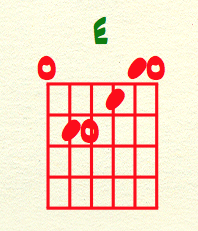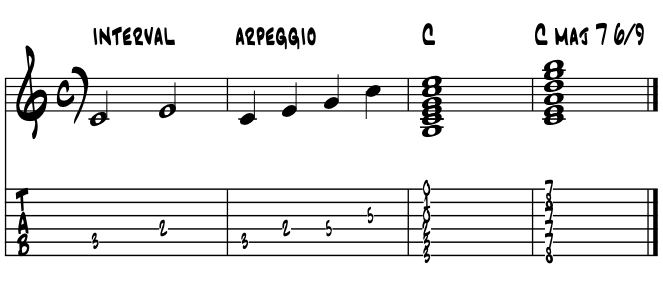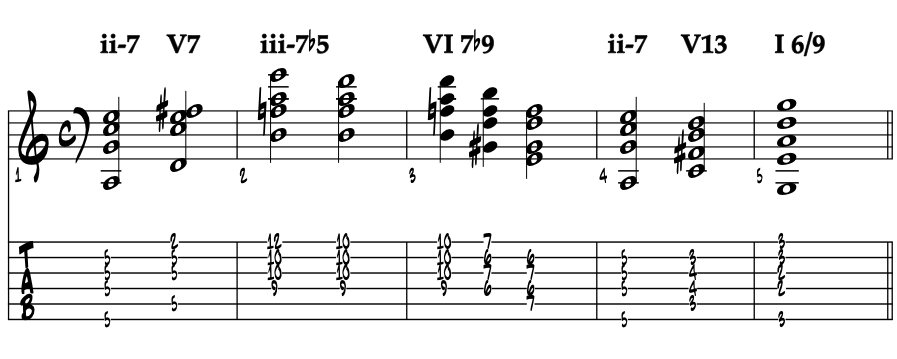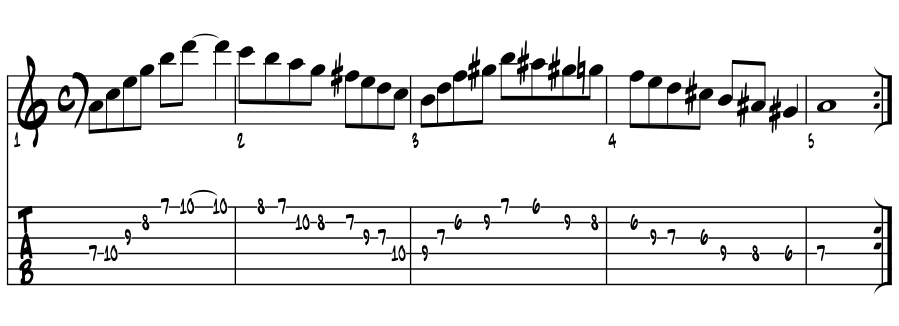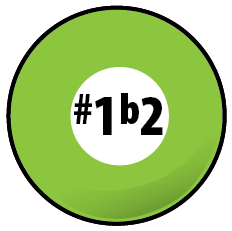In a nutshell. The major third is termed the mediant in legit theory circles. It is the essential pitch to making any of our scales, arpeggios, chords to sound major as opposed to minor. Major or minor ? Yin or Yang ? All hinges on the quality of the 3rd above a chosen root pitch. No substitutions !!! :) Just some set in ancient stone, and now global, music theory. |
For the major 3rd interval above a root pitch, is the key component to make any scale, arpeggio, chord, song, key etc., sound major. And of course it is the sweetness of a graciously sounded major third, really first among all of our possible intervals, that not only can melt a heart and fill us with love, but then lift to renew our spirit of earthly trials, from the darkest of darks towards that light, who's brightness knows of no earthly limits :) |
"Tis' always darkest before the dawn." |
all of us
|
Phrygian mode. And as with each of our seven diatonic pitches, we build the now ancient mode on Three, that we still today call the Phrygian mode. Phrygian's minor character immediately bring to life a true Spanish / Flamenco music and its super dramatic dance essence, deeply passionate pitches that resonate through powerful rhythms. That near any tune-able six string beater has these pitches easy, with one chord shape too, speaks mountains to Phrygian's historical build into a guitar and its ancient calling powers. Here's the chord shape. Find a flashy rhythm, play an 'E, F, G, F, E' pattern with this chord shape. You'll hear it :)
So we build a minor mode on the major 3rd above our root pitch. That's curious n'est-ce pas ... ? |
|
Major 3rd, where in the music. We'll find the major third when our songs are in a major key. From children's songs through folk, pop, rock, country, blues and jazz, the major third sets the tonality. With near nine out of ten songs written in a major key, we'll find this major third all over the Americana musical spectrum of sounds and styles. And anytime Hollywood needs the Spanish / Flamenco magic, Phrygian mode is the first 'go to' group of pitches of choice. |
A major third melody. Well, speaking of the joyous fiddle tunes and the nature of our major third, remember this classic melody ditty? Note that the first pitch in this arrangement is the major 3rd of the key center, as the pickup note into the line, so '3 4 5.' Quite the launch ! Example 1. |
|
 |
Know this melody ? Consider learning it here if need be. For surely it has the 'big 4', quarter note bring the swing, if so inclined course. |
Additional melodies that start on Three. "Mary Had A Little Lamb", which Stevie Ray Vaughn cooked to perfection :) James Pierpont's "Jingle Bells" of course. John Coltrane's rollicking modulating extravaganza "Moment's Notice" begins on the major 3rd. Also the Wolf/Landesman classic "Spring Can Really Hang You Up The Most." Both essential jazz tunes for sure. The bluegrass standard "Friend Of The Devil" by Jerry Garcia and Robert Hunter, on and on and on. |
|
Interval. The theoretical distance between One and Three in the major diatonic scale is a major third. This interval is two whole steps. Thinking C major, our pitches are the root C and E, a major 3rd above or two whole steps above. This is the major 3rd interval we find in any of our major triads / chords. Example 1a. |
|
Interval studies. Once our diatonic scales are mastered as whole steps and half steps, inspired players move on to the interval studies to help round out their melodic resource and vocabulary. Thirds are the next step in this evolution of our melodic resource studies. In C major, here's one scale study in diatonic thirds. Example 1b. |
 |
Cool ? Already starting to sound like music and a melody? Sense the sequencing in the pitches ? Is all of music just sequences woven together ? Is our own life a fluid sequencing of day to day events ? |
Key center. As a key center, upon the third degree of the diatonic major scale we locate the Phrygian mode. Overall minor in its tonality, Phrygian is the core guitar color that creates the Spanish / Flamenco sounds often filtered into the American musical fabric. Examine the pitches of E Phrygian as extracted from the pitches of the C major / diatonic scale. Another essential scale created from within a scale? You guessed it. Example 2. |
|
Phrygian melody. Yep, the Phrygian scale is minor, created from the major Ionian. One of four minor colors within the diatonic realm. Do notice how we've simply reshaped our core scale formula to create the Phrygian grouping, by simply moving the first two whole step intervals to the end of the group, thus simply a different section of our loop of core pitches. This positions the Phrygian to begin with its character half step interval. |
A quite common historical aspect of this group is that the chords used to support Phrygian minor melodies are very often all major triads built upon the first three pitches of the mode. So sort of a 'Phrygian rub?' Like the 'blues rub?' Yep, exactly. Example 2a. |
 |
The sound is built right into the pitches. The beginning half step so very often gives the mode away. Do notice the G# in the first chord of the example just above. It's surely not diatonic but often essential in creating the Phrygian feel. All depends on the line. |
Some Phrygian guitar magic. Also, do try this chordal idea without the barre for the F and G chords, and let those open strings ring right on out. Flamenco wizards such as De Lucia often strum using the tops of the nails on their strumming hands very very rapidly. Also try brushing or fanning the fingers down and drag the thumb nail back up for a counter rhythm. |
|
Harmony. Leaving our discussion of the Phrygian mode for now, let's get back to our discussion of all things diatonic Three. The chord built on the third degree of the diatonic major scale, our Three chord, is at its core a minor triad. It plays an important role in most of the American styles. Example 3. |
 |
Man that open E minor is one potent group of pitches. These two chords are close in the arpeggio of course, one pitch away really. Example 3a. |
|
A slight variation creates another classic motion. This next idea simply rearranges the last two chords and adds one more. Here we start on One, move to Three on our way to Four. Example 3b. |
 |
Telling stories. The chord progression in this last idea is the core motion of a song titled "The Weight", by a musical group known as The Band. If your musical interests are anywhere in the folk, gospel, blues or rock direction, learn this tune. These are also cool chords in a reggae feel. Just a nice solid, non dominant loop that easy cycles and cycles right along. Great for telling a story, just might need a 8 bar bridge with a V7 to bring it around. Hmm ... got a hook for this one? |
|
Three / Six / Two / Five / One. Well thanks in part to our Baroque brethren, we have what we often call 'cycles of chords.' The following idea is one of these cycling critters. The Three / Six / Two / Five / One chord progression is an essential cycle of fourths motion that while sometimes found in pop music, it's mostly a jazz event. Thinking C major is our key, let's examine the following table of scale degrees, pitches and the ever handy cycle of 5th's picture and locate this sequence of pitches. Example 4. |
|
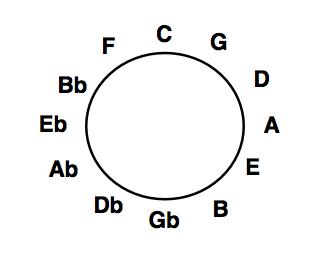 |
From the chart we determine that the pitches represented by the numbers Three / Six / Two / Five / One motion in C major are E, A, D, G and C. The pitch E is Three, A is Six etc. We're simply replacing the numbers with corresponding letters according to key. Finding the letter name E on our cycle of 5th's keyclock, we simply work our way back counterclockwise to our tonic pitch C. Jazz artists might know this as backpedaling. Here are the pitches. Example 4a. |
Building our diatonic triads on each of these pitches, we evolve the following chord progression. Example 4b. |
 |
"All just 3/6/2/5." As students of Wendy Williamson, we heard this quote a number of times. Mr. Williamson, with his good humor and incredible piano playing, could and often would elevate or reduce everything into this root motion and chord progression. Years later it became a core link to understand the historical evolutions of Americana harmony. |
In using just the Three / Six / Two / Five, we gain a cycle of chords beloved of the jazzers, whom will often use the motion as an intro / outro or vamp, for extending tunes or warming up. Once we evolve past just using the diatonic pitches, especially in making both Six and Five dominant chord types by adding their tritone within, it's pretty much game on in regards to substitutions, many ways to reshape the motion through exploration and its effect on the art being created. |
Half diminished color / chords. This next idea is a Americana as our chords might ever get. We borrow a bit of blue to make up a fancy sounding Three chord, that sets up the sene of the resolution just ahead real nice. Here's the lick using some Hollywood chords from the Good Doctor. Thinking 'G' major, here's a Two / Five / Three / Six cycle and resolution of chords. Ex. 4c. |
Nice changes huh ? This last idea might be among the most common for using the half diminished chord color in the major tonality. |
|
Half diminished color / scales. This next idea is simply a melodic realization of the first three bars of the chord progression of the last example. Example 4d. |
Sound ok ? It's jazzy for sure, with 1/8th notes too ! Using the diminished arpeggio / scale shape / arpeggio over a Three and Six chord pairing is pure Americana with 'b5 and b9' colortones as a common tone between the iii and VI chords. Jazz leaning ? Shed these shapes up and down the neck, keep track of potential resolutions to the various key centers long the way. |
In the minor tonality. Our Three chord in the minor tonality is diatonically a major triad. Defaulting to our root pitch of A, and the diatonic natural minor grouping of pitches, examine the pitches as we extract its Three chord. Example 5. |
|
Easy do yes ? Cool with extracting the pitches from the scale to create the chord? Ok with the spelling of chords? How our scales become arpeggios and arpeggios become chords? Cool. If not, I'll be honored to be the one to hip you to the changes :) |
A fairly common cycle of chords. This next idea starts us out on the minor One chord then uses the three major triads within our key center to close up the loop. Example 5a. |
Cool ? Extra push to minor with the augmented 5th of the V7, that one pitch tritone in relation to our tonic center pitch, so 'A to Eb.' |
Review. So we've a few solid and essential ideas surrounding Three. The major and minor triads and of course it's Phrygian mode, which goes way back in our histories. There's the '3 / 6 / 2 / 5' motions, so very common in popular Americana songs. A common turnaround in songs, we can alter this '3 6 2 5' motion and begin our historical evolutions towards the eventual chromaticism and free jazz of the middle 1960's. |
|
"The drummer; he inspired me to play like no one else I have ever met. |
wiki ~ Chet Baker
|
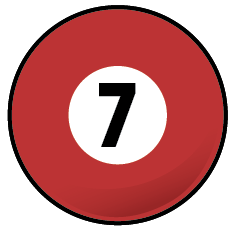 |
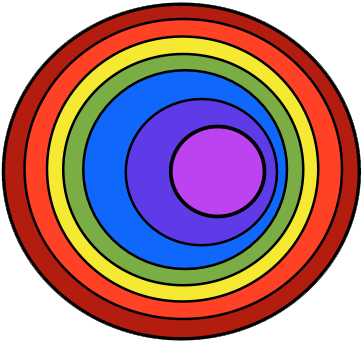 |
|||||||||||
 |
 |
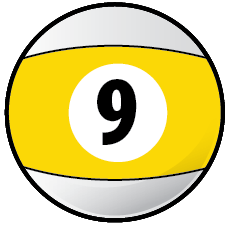 |
 |
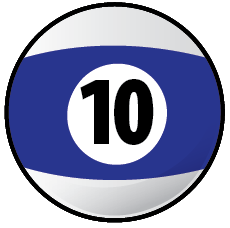 |
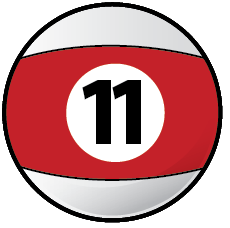 |
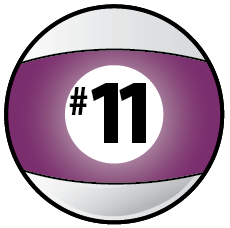 |
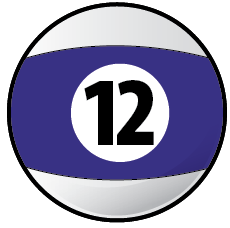 |
 |
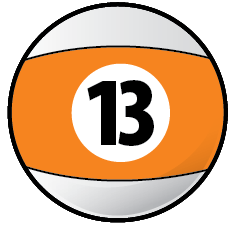 |
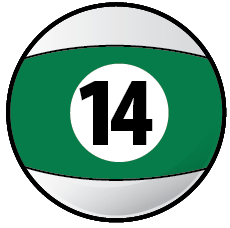 |
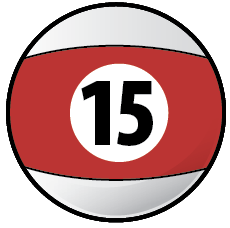 |
 |
References. References for this page's information comes from school, books and the bandstand and made way easier by the folks along the way. |
Find a mentor / e-book / academia Alaska. Always good to have a mentor when learning about things new to us. And with music and its magics, nice to have a friend or two ask questions and collaborate with. Seek and ye shall find. Local high schools, libraries, friends and family, musicians in your home town ... just ask around, someone will know someone who knows someone about music and can help you with your studies in the musical arts. |
|
Always keep in mind that all along life's journey there will be folks to help us and also folks we can help ... for we are not in this endeavor alone :) The now ancient natural truth is that we each are responsible for our own education. Positive answer this always 'to live by' question; 'who is responsible for your education ... ? |
Intensive tutoring. Luckily for musical artists like us, the learning dip of the 'covid years' can vanish quickly with intensive tutoring. For all disciplines; including all the sciences and the 'hands on' trade schools, that with tutoring, learning blossoms to 'catch us up.' In music ? The 'theory' of making musical art is built with just the 12 unique pitches, so easy to master with mentorship. And in 'practice ?' Luckily old school, the foundation that 'all responsibility for self betterment is ours alone.' Which in music, and same for all the arts, means to do what we really love to do ... to make music :) |
 |
"These books, and your capacity to understand them, are just the same in all places. Always bear in mind that your own resolution to succeed, is more important than any other one thing." |
|
Academia references of Alaska. And when you need university level answers to your questions and musings, and especially if you are considering a career in music and looking to continue your formal studies, begin to e-reach out to the Alaska University Music Campus communities and begin a dialogue with some of Alaska's finest resident maestros ! |
|
~ |



